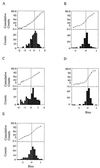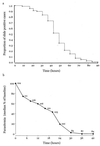Population pharmacokinetics of intramuscular quinine in children with severe malaria
- PMID: 11353629
- PMCID: PMC90549
- DOI: 10.1128/AAC.45.6.1803-1809.2001
Population pharmacokinetics of intramuscular quinine in children with severe malaria
Abstract
We present the first population pharmacokinetic analysis of quinine in patients with Plasmodium falciparum malaria. Ghanaian children (n = 120; aged 12 months to 10 years) with severe malaria received an intramuscular loading dose of quinine dihydrochloride (20 mg/kg of body weight). A two-compartment model with first-order absorption and elimination gave post hoc estimates for pharmacokinetic parameters that were consistent with those derived from non-population pharmacokinetic studies (clearance [CL] = 0.05 liter/h/kg of body weight; volume of distribution in the central compartment [V(1)] = 0.65 liter/kg; volume of distribution at steady state = 1.41 liter/kg; half-life at beta phase = 19.9 h). There were no covariates (including age, gender, acidemia, anemia, coma, parasitemia, or anticonvulsant use) that explained interpatient variability in weight-normalized CL and V(1). Intramuscular quinine was associated with minor, local toxicity in some patients (13 of 108; 12%), and 11 patients (10%) experienced one or more episodes of postadmission hypoglycemia. A loading dose of intramuscular quinine results in predictable population pharmacokinetic profiles in children with severe malaria and may be preferred to the intravenous route of administration in some circumstances.
Figures




References
-
- Agbenyega T, Angus B, Bedu-Addo G, Baffoe-Bonnie B, Guyton T, Stacpoole P, Krishna S. Glucose and lactate kinetics in children with severe malaria. J Clin Endocrinol Metab. 2000;85:1569–1576. - PubMed
-
- Barennes H. Intramuscular injections in sub-Saharan African children, apropos of a frequently misunderstood pathology: the complications related to intramuscular quinine injections. Bull Soc Pathol Exot. 1999;92:33–37. . (In French.) - PubMed
-
- Brodribb C. Quinine necrosis of muscle. Br Med J. 1922;ii:109.
-
- English M, Wale S, Binns G, Mwangi I, Sauerwein H, Marsh K. Hypoglycaemia on and after admission in Kenyan children with severe malaria. QJM. 1998;91:191–197. - PubMed
-
- Fletcher W. Notes on the treatment of malaria with the alkaloids of cinchona. Vol. 18. London, United Kingdom: John Bale, Sons & Danielsson, Ltd.; 1928.
Publication types
MeSH terms
Substances
Grants and funding
LinkOut - more resources
Full Text Sources

